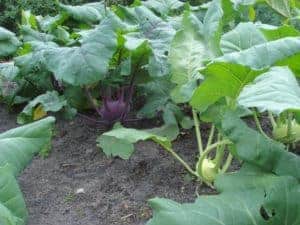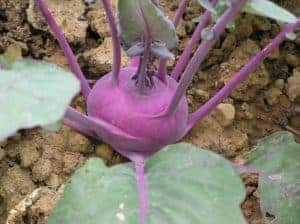Kohlrabi is seriously underrated as a vegetable. It’s basically the same species as kale, broccoli, cauliflower, cabbage, and collards, yet hardly anyone grows it and it’s seen as more of a curiosity at the supermarket than a staple in the kitchen. But kohlrabi is a versatile, delicious vegetable that tastes much better when you grow it yourself. Think of a broccoli stem that is round, crisp like an apple, and actually has a kind of sweet taste–which only gets sweeter when grown in cool weather. It also doesn’t spoil for a long time and it’s very easy to grow.
Kohlrabi can be direct sown a few weeks before your last frost for a summer harvest or eight weeks before your first frost for a fall harvest. It can also be sown indoors and transplanted out when your kohlrabi has its first two true leaves. Kohlrabi can be planted either in-ground at least 8 inches (20 cm) apart or in a container at least 10 inches (25 cm) deep with a volume of at least 2 gallons (7.5 L) for adequate space to grow. Kohlrabi can thrive with any well-balanced fertilizer and grows best in full sun.
On this page:
When to Plant and Harvest Kohlrabi
Direct Sow
Kohlrabi, much like kale, radishes, and lettuce, can be sown directly outdoors, even before your average last frost date. For spring planting, sow seeds directly from a few weeks before your last frost, up to your last frost date. When direct sowing, I drop 2-3 seeds into each hole, about 1/4 inch (5 mm) deep, spaced at least 8 inches (20 cm) apart, then thin out to one plant after they sprout.
Keep in mind if you direct sow in spring while it’s still cold outside, your kohlrabi will take longer to sprout and will grow more slowly until the weather warms up. Sowing under covers or keeping some plastic over it on very cold days can also help it grow faster.
I plant two crops of kohlrabi, first in early spring and again in late summer, and I always get better results from late summer plantings because they mature in the fall and produce larger, more delicious bulbs in cool weather. If you live in a climate with extremely hot summers, or you’ve grown kohlrabi sowed in spring and failed, I recommend planting for the fall garden.
Kohlrabi grown for fall harvests should be planted about two to three months before your average first frost date, depending on the variety. I just take whatever the days to maturity is on my packet of seeds and count backwards from my first frost. But don’t worry too much about it because kohlrabi is frost hardy and will survive those early frosts. Much like kale, kohlrabi actually tastes better when it matures in the cold.
Sow Indoors and Transplant
Another option is to sow indoors and transplant. I do this for all my summer/fall plantings because I can replace one crop with another right away with transplants without having to wait for the seeds to germinate. In my case, I usually transplant my kohlrabi a few weeks after harvesting my garlic (which is usually sometime in July), so they’re often in the ground at the end of July or beginning of August.
Transplant your kohlrabi when it has at least two true leaves (the two leaves after the initial two seed leaves).
 Growing Kohlrabi in Containers
Growing Kohlrabi in Containers
11I have experience growing them in both containers and in garden beds. Kohlrabi is well-suited to growing in containers as long as the size is large enough, it has enough fertilizer, and doesn’t dry out.
Kohlrabi should be grown in at least 2-gallon (7.5 L) containers at least 10 inches (25 cm) deep. People can successfully grow them in 1-gallon (3.8 L) containers, but in my experience, there is a higher chance of getting small bulbs or no bulbs at all in small pots. Make sure your container is filled with well-draining potting mix and has drainage holes on the bottom.
Light Requirements for Kohlrabi
Kohlrabi grows best in full sun. A south-facing garden bed, balcony, or patio is ideal. If you live in a very hot climate, one thing you can do is grow it against an east-facing fence, wall, or hedge/trees so it can get that gentle, morning sun and then get some shade in the hot afternoons.
How to Fertilize Kohlrabi
Kohlrabi is a moderate feeder and only needs a good balanced fertilizer to thrive. Go for something with a balanced NPK or something with a little more nitrogen. You can add some organic slow-release fertilizer after transplanting that can last the whole season or you can use a liquid fertilizer and feed your kohlrabi every 7-14 days. Adequate fertilizer is especially important for kohlrabi grown in containers as they can quickly deplete the potting mix of nutrients after a month or so.
When to Harvest Kohlrabi

Kohlrabi is just a swollen stem, so you can pick it at any time, even when it’s just a tiny bulb, but most kohlrabi varieties are ready after 8-12 weeks. It’s usually recommended to wait until it’s about 2 1/2 to 3 inches (6.3 to 7.6 cm) for most varieties, such as my favorite Purple Vienna kohlrabi. Some varieties can get much, much larger, such as the Superschmelz kohlrabi and Dyna kohlrabi, both of which can get over 8 inches (20 cm) in diameter. As mentioned before, if you want to maximize the size (and flavor) it’s better to plant it in late summer for a late fall harvest.
Kohlrabi Pests
The two main pests you will deal with are cabbage loopers (cabbage moth) and cabbage worms (small white butterfly). These go after all your cruciferous vegetables like kale, broccoli, cabbage, cauliflower, and kohlrabi. You can check under the leaves for individual tiny white eggs sticking out and remove them, or you can use insect netting to cover them.
Since people mainly grow kohlrabi for the bulbs, these pests are usually not a serious problem unless they completely defoliate your plant, and they usually won’t eat the actual bulb itself. General predators like spiders, wasps, and ladybugs eat the eggs and worms, and in my area, at some point in July the wasps always start clearing them out and save me from the hassle.
